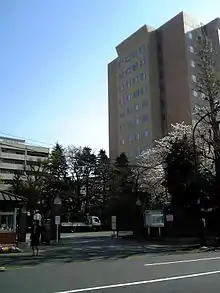Japan Women's University
Japan Women's University (日本女子大学, Nihon joshi daigaku) is the oldest and largest of private Japanese women's universities. The university was established on 20 April 1901 by education reformist Jinzo Naruse.[1]
Japan Women's University | |
 A building of the Japan Women's University | |
| Type | private |
|---|---|
| Established | 1901 |
Academic staff | 200 (approx.) |
| Students | 6000 (approx.) |
| Website | www.jwu.ac.jp |
The university has around 6000 students and 200 faculty. It has two campuses, named after the neighborhoods in which they are located: Mejirodai (目白台) in Bunkyō, Tokyo, and Nishi-Ikuta (西生田) in Tama, Kawasaki, Kanagawa Prefecture.
There are associated schools from kindergarten through senior high school.
History
Japan Women's University was founded by educator Jinzo Naruse in 1901.[1][2] Initially, the university comprised three departments: home economics, Japanese literature, and English literature.[2]
Faculty
Notable alumnae
- Tsuruko Haraguchi, first Japanese woman to earn a doctorate in psychology
- Yumie Hiraiwa, novelist
- Raicho Hiratsuka
- Tano Jōdai, sixth president of Japan Women's University
- Hideko Inouye, first woman president of Japan Women's University[3]
- Shina Inoue Kan
- Tsuruyo Kondo, politician
- Tomi Kora, politician
- Keiko Matsui
- Ayame Mizushima, screenwriter
- Yuriko Miyamoto
- Kazuyo Sejima, architect
- Rumiko Takahashi, manga artist
- Toshiko Tamura
Access
The closest train stations to the Mejiro Campus are:
- Tokyo Metro Fukutoshin Line: About 8 minutes by foot from Zoshigaya Station (exit 3)
- Tokyo Metro Yurakucho Line: About 10 minutes by foot from Gokokuji Station (exit 4)
References
- "Japan Women's University | Outline | History". www.jwu.ac.jp. Retrieved 22 January 2019.
- Omori, Hideko (2013). "Religious Education Leading to Higher Education for Women: Historical Insights on Modern Japan". Religious Education. 108 (5): 529–541. doi:10.1080/00344087.2013.835650. ISSN 0034-4087. S2CID 144844275.
- Schneider, Michael (2007). "Were Women Pan-Asianists the Worst?: Internationalism and Pan-Asianism in the Careers of Inoue Hideko and Inoue Masaji". In Saaler, Sven; Koschmann, J. Victor (eds.). Pan-Asianism in Modern Japanese History: Colonialism, Regionalism and Borders. London, UK: Routledge. p. 125. ISBN 978-1-134-19380-6.